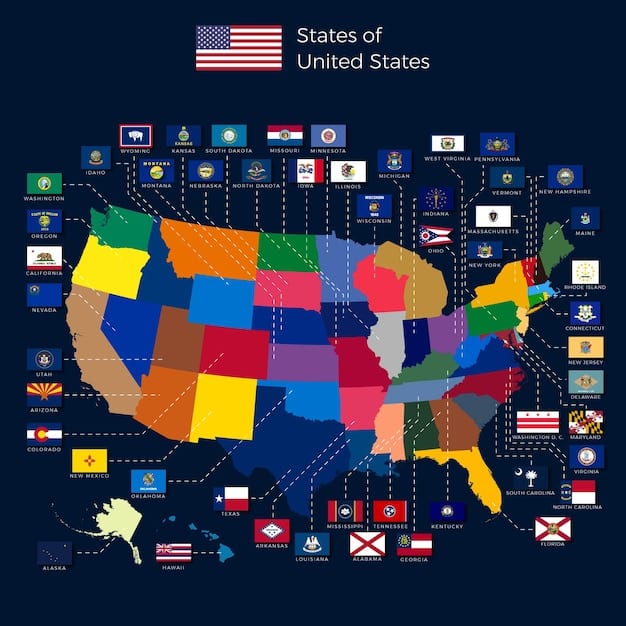TANF 2025: Eligibility & Benefits for Needy Families Explained

The Temporary Assistance for Needy Families (TANF) program offers time-limited financial and support services to eligible low-income families in the United States, aiming to promote self-sufficiency and economic stability by 2025.
Navigating government assistance programs can often feel complex and overwhelming. For families facing economic hardship, understanding programs like the Temporary Assistance for Needy Families (TANF): Eligibility and Benefits Explained for 2025 is crucial. This guide aims to demystify TANF, offering clarity on its purpose, who it serves, and what potential beneficiaries can expect in the coming year, providing a clear path forward for those seeking support.
Understanding the Foundation of TANF
The Temporary Assistance for Needy Families (TANF) program is a cornerstone of the United States’ welfare system. Established by the Personal Responsibility and Work Opportunity Act of 1996, TANF replaced the Aid to Families with Dependent Children (AFDC) program. Its primary goal is to provide temporary cash assistance and support services to needy families with children, fostering economic independence and reducing long-term welfare reliance.
Unlike its predecessor, TANF introduced significant changes, including time limits on benefits, increased work requirements, and greater state flexibility in administering programs. States receive block grants from the federal government and have substantial latitude in designing their own TANF programs, leading to variations in eligibility criteria and benefit levels across the nation.
Core Objectives of TANF
The federal law outlines four main purposes for the TANF block grant, which guide state programs:
-
Provide assistance to needy families: This specifically targets families so that children can be cared for in their own homes or in the homes of relatives.
-
End welfare dependency: By promoting job preparation, work, and marriage, the program seeks to transition families from government assistance to self-sufficiency.
-
Reduce out-of-wedlock pregnancies: TANF programs often include initiatives to prevent and reduce the incidence of out-of-wedlock pregnancies.
-
Encourage the formation and maintenance of two-parent families: This objective reflects a societal value placed on stable family structures.
These objectives highlight a shift from simple income maintenance to a more holistic approach that emphasizes personal responsibility and family well-being. The emphasis on work and family stability is a defining characteristic of TANF.
The program aims to offer a safety net while encouraging recipients to improve their circumstances. This dual focus means states often blend financial aid with work support, childcare assistance, and other services designed to remove barriers to employment. The success of TANF is often measured by its ability to move families off public assistance and into sustainable employment, thereby enhancing their overall quality of life and contributing to the economic health of communities.
In summary, understanding TANF’s fundamental principles is key to appreciating its role in supporting vulnerable families. It’s not merely a handout but a structured pathway designed to empower individuals and families to achieve self-sufficiency, ensuring children grow up in stable and supportive environments, even in challenging economic times. The flexibility afforded to states allows for tailored approaches that reflect local needs and economic realities, creating a diverse landscape of TANF programs nationwide.
TANF Eligibility Requirements for 2025
Determining eligibility for TANF can be a nuanced process, as requirements often vary by state. However, there are fundamental federal guidelines that all states must adhere to. As we look towards 2025, these foundational criteria remain consistent, providing a general framework for potential applicants.
The primary criterion for eligibility is financial need, often defined by income and asset limits. These limits are typically set at a percentage of the federal poverty level, but the exact thresholds differ considerably from state to state. Generally, families must demonstrate that their income is below a certain level and that their assets (excluding certain exempted items like a primary residence or one vehicle) do not exceed a specified amount.

Federal and State-Specific Rules
While the federal government sets broad parameters, each state has the authority to define specific rules for its TANF program. This autonomy means a family eligible in one state might not qualify in another, even if their financial circumstances are identical. States may impose additional requirements related to:
-
Residency: Applicants typically must be residents of the state where they are applying for benefits.
-
Citizenship Status: Generally, recipients must be U.S. citizens or qualified non-citizens. Specific rules apply to different immigration statuses.
-
Family Composition: TANF is designed for families with children. This typically means a minor child living with a parent or a relative caregiver. Pregnant women in their third trimester may also qualify.
Beyond these demographic and financial criteria, states often implement what are known as “diversion programs” or “work-first” initiatives. These programs aim to prevent long-term welfare dependence by immediately connecting applicants with employment services or offering a one-time cash payment to address a temporary crisis, thereby avoiding the need for ongoing TANF benefits.
A critical aspect of TANF eligibility, especially for adults, revolves around work requirements. Federal law mandates that states ensure a certain percentage of TANF recipients are engaged in work activities. These activities can include unsubsidized employment, subsidized employment, on-the-job training, work experience, community service, vocational education, job search and readiness, and providing childcare for a community service participant.
The time limits on receiving TANF benefits are another crucial eligibility component. Federally, there’s a 60-month (five-year) lifetime limit on receiving federal TANF funds. However, states can impose shorter limits themselves. There are also provisions for states to exempt a small percentage of recipient families from these time limits due to hardship or domestic violence. Understanding these time limits is vital for families planning their financial future.
In essence, prospective TANF applicants in 2025 should be prepared for a thorough review of their financial situation, family composition, and willingness to engage in work-related activities. It is highly recommended to contact the specific state’s social services agency or welfare department for the most accurate and up-to-date eligibility requirements, as these are subject to state-level policy decisions and annual adjustments based on economic conditions and legislative changes.
The emphasis on eligibility details reflects the program’s balance between providing a necessary safety net and promoting self-sufficiency. Applicants must navigate these specific requirements to access the support designed to help them transition to greater long-term economic stability.
Exploring TANF Benefits and Services for 2025
The benefits provided through the Temporary Assistance for Needy Families (TANF) program extend far beyond simple cash assistance. While direct financial aid is a critical component, TANF is designed to offer a comprehensive suite of services aimed at improving family well-being, promoting economic self-sufficiency, and addressing the root causes of poverty. For families in 2025, understanding the full spectrum of available benefits is essential for maximizing the program’s potential impact.
Cash assistance, often referred to as “welfare payments,” provides direct financial support to eligible families to help cover basic living expenses such as housing, food, and utilities. The amount of cash assistance varies significantly by state, reflecting differences in cost of living and state-specific policy choices. These payments are typically modest and are intended to be temporary, complementing other support structures.
Types of Support Offered
Beyond direct cash aid, TANF programs nationally provide or facilitate access to a wide array of support services, which can include:
-
Work Support and Job Training: This is a cornerstone of TANF. Programs include vocational training, job search assistance, resume writing workshops, interview preparation, and placement services to help adults secure and retain employment. Some states also offer subsidized employment programs.
-
Child Care Assistance: To enable parents to work or participate in training, TANF can fund child care subsidies, making quality care more affordable and accessible. This is invaluable for single-parent households or families where both parents need to work.
-
Transportation Assistance: Covering costs associated with commuting to work or training, such as bus passes, gas vouchers, or vehicle repair assistance, helps remove a common barrier to employment.
-
Education and Training: Support for GED attainment, adult basic education, or certain post-secondary education programs can improve long-term earning potential.
-
Parenting Skills and Family Counseling: Programs aimed at strengthening family units, improving parenting skills, and addressing issues like domestic violence or substance abuse are often available.
-
Diversion Payments: As mentioned, some states offer one-time cash payments to families facing a short-term crisis (e.g., car repair, eviction notice) to prevent them from needing long-term TANF assistance.
The specific combination and availability of these services depend heavily on the state and sometimes even the county where a family resides. State TANF plans are continually adapted to address local economic conditions and social needs. For example, a state with high unemployment might focus more heavily on job placement services, while another facing a housing crisis might prioritize rental assistance and homelessness prevention.
Beneficiaries often engage with a case worker who helps tailor a “personal responsibility plan” or “individual responsibility plan.” This plan outlines the activities and requirements the recipient must fulfill to continue receiving benefits, such as participation in work activities, school attendance for children, or regular health check-ups. The goal is to move families toward self-sufficiency progressively.
It’s important to recognize that TANF benefits are time-limited, emphasizing their temporary nature. This aspect encourages beneficiaries to use the support to transition to stable employment and financial independence. The focus is always on creating pathways out of poverty rather than maintaining a state of dependence on government aid, aligning with the program’s core philosophy.
Families considering TANF should proactively inquire about the specific benefits and services available in their state. Accessing this full range of support can significantly enhance their ability to overcome current challenges and build a more stable future. TANF aims to be a spring-board, not a hammock, providing comprehensive tools for positive change.
Applying for TANF: A Step-by-Step Guide Towards 2025
The application process for Temporary Assistance for Needy Families (TANF) can appear daunting, but breaking it down into manageable steps can clarify the pathway to assistance. While specific steps and required documentation may vary slightly by state, the general procedure remains consistent across the United States. Preparing adequately can significantly streamline the process for applicants in 2025.
The first and most crucial step is to gather all necessary documentation. This typically includes proof of identity for all family members (birth certificates, social security cards, photo IDs), proof of residence (utility bills, lease agreements), income verification (pay stubs, tax returns, unemployment benefits statements), and asset information (bank statements, vehicle titles). Additionally, documents proving household composition, such as school enrollment records for children, will likely be required.
Key Application Phases
The application process generally unfolds in several distinct phases:
-
Initial Contact and Information Gathering: Begin by contacting your state or local welfare agency. Many states offer online portals or downloadable forms for preliminary applications. This initial step helps you understand specific state requirements and acquire the application packet.
-
Submitting the Application: Once all forms are completed and documents are collected, submit your application. This can often be done online, by mail, or in person. It’s advisable to keep copies of everything submitted for your records.
-
Interview Process: After submission, you will likely be scheduled for an interview with a caseworker. This interview is a critical step where you can discuss your situation, clarify any information, and answer questions about your eligibility. Be prepared to provide detailed financial information and explain your family’s needs.
-
Verification and Review: The caseworker will independently verify the information provided, which may involve contacting employers, landlords, or other agencies. This phase ensures the accuracy and legitimacy of the application.
-
Decision and Notification: Once the review is complete, the agency will make a decision regarding your eligibility. You will be notified in writing of the outcome, including the reasons for approval or denial and information on how to appeal a decision if you believe it’s incorrect.
Throughout the application process, honesty and thoroughness are paramount. Providing inaccurate or incomplete information can lead to delays or even denial of benefits. If you have questions or encounter difficulties, do not hesitate to ask your caseworker or seek assistance from legal aid organizations or local community support groups.
Many states now offer resources to help navigate the application process, from dedicated phone lines to online tutorials. Leveraging these resources can significantly ease the burden on applicants. Additionally, be aware that many states prioritize applications from families facing immediate crises, so communicating any urgent needs during the initial contact can be beneficial.
It’s also important to note that if your circumstances change after you apply or begin receiving benefits (e.g., a new job, a change in household size), you are typically required to report these changes to the agency promptly. Failure to do so can result in overpayments that you may be required to pay back or even lead to sanctions.
By approaching the TANF application with diligence and attention to detail, families can effectively navigate the system and access the vital support designed to help them achieve greater financial stability. This proactive approach ensures that the path to assistance is as smooth and efficient as possible, ultimately helping families move towards self-sufficiency within the framework of the program.
Work Requirements and Time Limits in TANF
A central pillar of the Temporary Assistance for Needy Families (TANF) program, distinguishing it significantly from previous welfare models, is its emphasis on work requirements and the imposition of time limits on receiving benefits. These elements are designed to promote self-sufficiency and prevent long-term reliance on government aid, reflecting a policy shift towards “workfare” rather than simply “welfare.” Families considering or currently receiving TANF in 2025 must clearly understand these critical provisions.
Federal law mandates that states require a certain percentage of their TANF recipients to participate in defined “work activities.” This requirement applies to adult recipients, typically excluding those caring for a very young child, those with a disability, or those who are otherwise exempt. The goal is to move recipients into employment as quickly as possible, fostering independence.
Mandatory Activities and Timeframes
The term “work activities” is broadly defined but includes specific categories:
-
Unsubsidized or Subsidized Employment: Working in a job without or with government wage subsidies.
-
On-the-Job Training: Learning job skills while working for an employer.
-
Work Experience: Unpaid work to gain skills and experience.
-
Community Service: Performing work for the benefit of the community.
-
Vocational Education Training: Education directly related to a job or specific occupation (with certain limits).
-
Job Search and Readiness: Activities like resume building, interview preparation, and job application.
-
Teen Parent Activities: For teen parents, attendance at high school or a GED program.
States have flexibility in determining the exact hours per week a recipient must engage in these activities, though there are federal minimums. Failure to comply with these work requirements, without a valid exemption, can result in sanctions, such as a reduction or termination of TANF benefits. This adherence to requirements underscores the program’s commitment to transitioning families towards economic independence.
The most significant change introduced by TANF was the implementation of a 60-month (five-year) federal lifetime limit on receiving TANF benefits. This means that, generally, a family cannot receive federal TANF funds for more than five years over their lifetime, regardless of whether the benefits were continuous or sporadic. States, however, have the option to impose shorter time limits, and many do.
There are provisions for exemptions to this time limit. States can exempt up to 20% of their caseload from the federal 60-month limit due to hardship or for families experiencing domestic violence. These exemptions are critical for cases where extreme circumstances prevent a family from achieving self-sufficiency within the standard timeframe. Each state defines its own hardship criteria, adding another layer of variation to the national TANF landscape.
For recipients, understanding and actively managing their time limits is crucial. Case managers typically work with families to develop plans aimed at achieving independence before exhausting their benefits. This includes connecting them with education, training, and employment resources. The time limit serves as an incentive for families to utilize the program’s support effectively and efficiently.
The dual focus on work requirements and time limits reflects TANF’s underlying philosophy: to provide a temporary bridge during periods of financial difficulty, rather than a permanent safety net. This approach encourages personal responsibility and underscores the expectation that families actively work towards becoming self-sufficient, thereby promoting their long-term well-being and reducing reliance on public assistance.
State-Specific Variations in TANF Programs
One of the defining characteristics of the Temporary Assistance for Needy Families (TANF) program is the substantial flexibility granted to individual states in designing and implementing their programs. Unlike many federal programs with uniform rules across the nation, TANF operates as a block grant, allowing states to tailor assistance and services to meet their specific populations’ unique needs and economic conditions. This flexibility results in significant state-to-state variations that prospective applicants in 2025 must be aware of.
The differences typically manifest in several key areas, profoundly impacting who qualifies for benefits and what assistance they receive. These variations are a direct consequence of the states’ authority to allocate their TANF block grant funds across a broad range of activities consistent with the program’s four purposes.
Key Areas of Divergence
The most prominent areas where states show significant variance include:
-
Eligibility Requirements: While federal law sets broad guidelines, states establish their own income and asset limits for qualification. These limits can differ dramatically, meaning a family that would qualify in one state might be ineligible just across the border in another. Some states also impose stricter residency requirements or drug testing policies.
-
Benefit Levels: The amount of monthly cash assistance provided to families varies enormously. For example, a family of three in California might receive a significantly different amount compared to a similar family in Mississippi, reflecting differences in both state policies and cost of living.
-
Time Limits: While a 60-month federal lifetime limit exists, states can impose shorter limits. Some states have “work-first” policies that reduce or terminate benefits much sooner if recipients don’t meet work requirements, while others are more lenient with their exemptions.
-
Work Activities and Sanctions: The specific types of “work activities” emphasized, the number of hours required, and the severity of sanctions for non-compliance can differ. Some states have very strict engagement requirements, while others offer more flexibility or additional support services to help recipients meet these requirements.
-
Use of Funds: States can use their TANF funds not only for direct cash assistance but also for a wide range of services and programs that meet the four TANF purposes. This can include child care, transportation, domestic violence services, prevention of out-of-wedlock pregnancies, and initiatives to support two-parent families. The proportion of funds dedicated to each area varies significantly, shaping the overall nature of the state’s TANF program.
Because of these wide-ranging differences, a crucial step for anyone seeking TANF assistance is to research their specific state’s program thoroughly. State welfare agencies or departments of human services are the primary sources of this information. Many states provide detailed brochures, websites, and guidance counselors to help potential applicants understand the local rules and available resources.

The implications of these state differences are profound. They highlight the importance of localized advocacy and policy-making to ensure that welfare programs effectively serve the unique needs of each state’s vulnerable populations. Understanding these variations empowers families to navigate the system more effectively and informs researchers and policymakers about the diverse landscape of safety net provisions across the nation.
Ultimately, while TANF is a federal program, its implementation is a mosaic of state-specific policies. This decentralization allows for responsiveness to local conditions but also requires careful attention from applicants to ensure they are fully informed about the rules and benefits applicable to their geographic area.
Future Outlook for TANF in 2025 and Beyond
As we look towards 2025 and the years beyond, the landscape for the Temporary Assistance for Needy Families (TANF) program is continuously shaped by ongoing policy discussions, economic shifts, and evolving societal needs. The program, designed with flexibility for states, remains a critical component of the social safety net, but its future trajectories are subject to various influences. Understanding these potential shifts is important for families and policymakers alike.
One major area of discussion revolves around the adequacy of benefit levels. For many years, the real value of TANF cash assistance has eroded due to inflation and stagnant benefit calculations in many states. Advocates often point to the insufficient nature of these benefits, arguing they do not adequately cover basic needs like housing and utilities, especially in high-cost-of-living areas. Future policy debates may center on calls for federal incentives or mandates for states to increase benefit levels to a more meaningful standard.
Potential Policy Evolutions and Challenges
Several factors could influence TANF’s evolution:
-
Economic Conditions: A significant economic downturn could place immense pressure on state TANF programs, potentially leading to increased caseloads and demand for services, testing the limits of the fixed federal block grant. Conversely, sustained economic growth might lead to decreased caseloads and greater state investment in work supports and long-term poverty prevention.
-
Workforce Changes: The evolving nature of work, including the rise of the gig economy and automation, presents challenges and opportunities for TANF’s work requirements. Programs may need to adapt to equip recipients with skills for future job markets and recognize diverse forms of employment.
-
Reauthorization and Funding Debates: While TANF is a permanent block grant, its specific funding levels are subject to congressional appropriations. Debates around federal funding and potential reauthorization could lead to changes in federal rules, work requirements, or time limits, reflecting new legislative priorities.
-
State Innovations: States will likely continue to innovate within the TANF framework. This could include new approaches to addressing homelessness, substance abuse, or domestic violence among TANF families, or exploring new models for workforce development that are more responsive to local labor market needs.
-
Focus on Wraparound Services: There’s a growing recognition that cash assistance alone is often insufficient to move families out of poverty. Future trends may see an increased emphasis on investing in comprehensive wraparound services—like mental health support, housing assistance, and quality childcare—to address deeper barriers to employment and stability.
The program’s inherent flexibility, while leading to state variations, also allows for adaptability. States can pivot their programs to focus on different aspects of family well-being, depending on their unique demographic shifts and economic realities. For example, a state experiencing a high rate of parental substance abuse might allocate more TANF funds to substance abuse treatment and prevention programs.
Challenges remain, including the persistent issue of benefit time limits and how they affect families who struggle to find stable employment within the five-year window. Policymakers continue to weigh the balance between encouraging work and providing a sufficient safety net for those facing significant barriers.
Ultimately, the future of TANF will likely involve a continuous balancing act between promoting self-sufficiency through work and providing compassionate support to the nation’s most vulnerable families. Ongoing research and advocacy will play a crucial role in shaping policy reforms, pushing for a program that is both effective in achieving its goals and responsive to the complex realities faced by needy families across the United States. The goal remains to empower families to build brighter, more stable futures.
| Key Point | Brief Description |
|---|---|
| 👪 Eligibility Factors | Primarily financial need, family composition, and state-specific residency and citizenship rules. |
| 💲 Benefit Types | Cash aid, work support, child care, and other services aimed at self-sufficiency. |
| ⏳ Time Limits | Federally capped at 60 months, but states can impose shorter limits with some exemptions. |
| 🌎 State Variations | Eligibility, benefit levels, and program structures differ significantly by state. |
Frequently Asked Questions About TANF
▼
The primary goal of TANF is to provide temporary financial and support services to needy families with children, aiming to foster economic independence and reduce long-term reliance on welfare. It emphasizes work and self-sufficiency, assisting families in transitioning from government aid to stable employment.
▼
TANF significantly differs from AFDC (Aid to Families with Dependent Children) by introducing time limits on benefits, implementing stricter work requirements, and granting states greater flexibility in program administration. AFDC was more focused on income maintenance without these stringent conditions.
▼
No, TANF benefits are not the same in every state. Due to the block grant structure, states have considerable flexibility in determining eligibility criteria, benefit levels, and the types of services offered, leading to significant variations across the nation.
▼
Federal law mandates that adult TANF recipients participate in “work activities” such as unsubsidized employment, job training, work experience, community service, or vocational education. States define specific hours and types of activities, with non-compliance potentially leading to benefit sanctions.
▼
The federal lifetime limit for receiving TANF benefits is 60 months (five years). However, states have the option to impose shorter time limits. There are provisions, such as hardship exemptions, that allow a small percentage of recipients to exceed this limit under specific circumstances.
Conclusion
The Temporary Assistance for Needy Families (TANF) program plays a vital role in the social safety net of the United States, offering a temporary bridge for vulnerable families facing economic hardship. By understanding its core principles, varied eligibility requirements, diverse range of benefits, and the critical emphasis on work and time limits, families can better navigate this complex system. As we move into 2025, TANF will continue to adapt to economic shifts and policy debates, striving to balance providing essential support with fostering long-term self-sufficiency. Empowering families with knowledge about TANF is crucial for enabling them to achieve greater stability and build a secure future.





